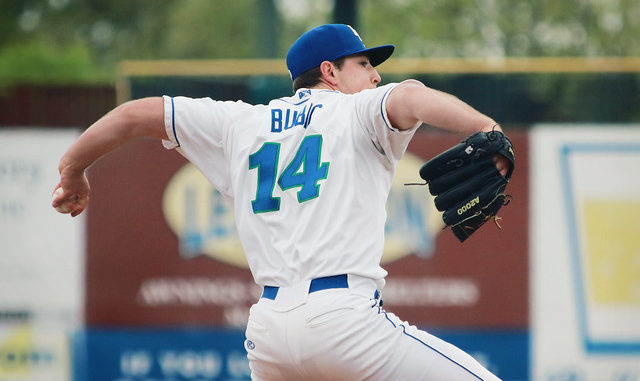
In my Royals midseason Top 50, I briefly mentioned the importance of context in regards to the Royals’ minor leaguers. After seeing MLB Pipeline’s midseason list, in which they dropped both Trevor Larnach and Jonathan India around 50 spots, I feel as if I should go into more detail on how important context is. This isn’t to say MLB Pipeline is necessarily wrong, however I disagree with this decision, and I think that it’s likely that their standard slashlines were valued a bit too much.
India’s slashline in A+, .256/.346/.410, looks fairly average at first glance, but it actually translated to a 125 wRC+ due to the harsh conditions of the FSL. Larnach is an even stranger case, as his A+ .316/.382/.459 slashline looks very good even if it weren’t the FSL, but since it is the FSL, it comes out to a 148 wRC+. Sure the power is not what it could be, but I’m just a bit confused how either of them dropped so far down the list.
This is relevant to Royals’ prospects because between Omaha, which plays in the PCL, and Wilmington which is one of the most pitcher friendly environments in all of baseball, the Royals have teams on both ends of the spectrum, which really provide proof to the importance of context. As I mentioned in my Top 50 List, the average OPS and ERA difference between the PCL and the Carolina League are about 150 points and 1.5 runs respectively. This means that if a player at Wilmington has a similar slashline to a player at Omaha, there is actually a significant difference between their performance.
For example, let’s take a look at Brewer Hicklen and Bubba Starling. Hicklen’s slash line at A+ was .263/.363/.427 (.790 OPS), which looks very similar to Starling’s .310/.358/.448 (.806 OPS) at AAA, however when you look deeper, Hicklen’s 131 wRC+ is far more impressive than Starling’s 96 wRC+. It’s very easy for people who aren’t following prospects as closely to take the stats at face value without truly knowing their value. A .809 OPS in a league where the average player has a .699 OPS is far more impressive than a .806 OPS in a league where the average player has .832 OPS.
This issue is arguably even worse for pitchers. The PCL especially has become borderline impossible for starting pitchers to pitch in. If you need proof of this, look no further than the Royals’ Foster Griffin. This year, Griffin had a 5.23 ERA and a 1.52 WHIP in 130.2 innings of work, and was named to the All-PCL team. Yeah that’s right, a guy with an ERA over 5 is considered to be one of the top SP in the entire league. Because of this, a guy like Griffin could be pitching well while having seemingly less attractive stats.
The inverse of this applies to the pitchers at the lower level. Not to discredit the improvements which guys like Kris Bubic and Jonathan Bowlan have made, but their stats are slightly skewed by the environment in which they play in. With the new ball in AAA especially, comparing prospects across levels has become extremely difficult, but it’s important to look past the statistics a bit.
Context is also important in terms of the stage of development that someone is in, as well as age. For example, Brewer Hicklen is 23 and in A+, so you could say that he’s a bit behind, but when you consider that he’s only been focusing on baseball alone for a few years, it shows how raw he is, and how much potential he truly has. On the inverse of that, just because a guy is raw doesn’t mean he’s raw and filled with potential. Everyone matures at different levels, and just because Woo-Young Jin and Luis De La Rosa are both about the same age doesn’t mean they have the same amount of room for improvement. While Woo-Young Jin’s stats in Arizona are amazing, I would say De La Rosa’s are arguably more impressive, given how raw he is as an athlete and how new he is to pitching.
This again applies to guys like Kris Bubic too. Bubic has been statistically one of the best pitchers in all of minor league baseball, but it’s important to remember that he was a college pitcher whose best trait was his pitchability, so he was expected to dominate the lower levels of the minor leagues. For guys like him, (Zac Lowther is another example), AA is where the test truly begins. If the Royals’ AA pitching staff wasn’t so stacked then Bubic would likely already be there, but we should get to see him there to start next year. I’m a huge Bubic fan, so I believe he’ll adjust just fine to AA (just like Lowther has), but I think people should remember both the environment in Wilmington and the type of pitcher that Bubic is when they’re looking at his stats.
The point that I’m trying to make is, while stats are amazing and extremely important, the story behind the stats is often just as important. Rankings, evaluations, opinions, etc. should never be made based off stats alone, and I feel as if that sentiment gets lost sometimes.





Leave a Reply